Retired law enforcement officer, Bryan Appleby – aka the Xtreme Boondocker – shares his personal safety advice for truck campers including potential threats, camping security, and dangerous animals.

“But there is no one around!”
That was the cry and tone of my new bride as we sat under the stars at a backcountry camp, in Arches National Park. We had just spent three hours four-wheeling to a very remote arch. We had set up our camp, and were now being shown a beautiful night show of stars in the moonless heavens above our head.
Not recognizing the initial tone of my wife’s earlier comment, I continued with my excited comments.
“Yeah! Can you imagine our luck? There is not a single person within miles and miles!”
“Yes, but there is no one anywhere around us”.
My bride, who had very little camping experience, was trying to convey to me her discomfort. I already had a lifetime of backpacking in some of the most remote areas of America. Of course I too was just beginning at one time. From her hesitation, I knew to go slowly until her comfort level, with remote camping, was established.
Thus begins the topic I wish to peel apart; personal safety and comfort level while camping off-the-grid, possibly alone, and away from populated areas.
As the majority of my camping is boondocking in remote locations, my sharing will be geared more towards this type of camping. However, much of what I am sharing can be used in more organized camping situations as well. Ultimately, I defer to your own judgment as only you can determine the style of camping that works for you, and how safe you feel while doing it.
What and whom should I guard against?
When I worked as a National Park Ranger, this was a frequent question. My answer was, “You should watch out for the most dangerous animal in the woods, Man!”
Yes, Man should be your first concern over any animal you might encounter. The people you should be concerned about are not necessarily the homeless, but more often the campers found around you.
That said, one should also be aware of snakes, birds, bears, and coyotes. The elements, including rain, wind, and even hurricanes and tornadoes, also pose a potential threat while truck camping. I will cover all of these topics.
How do I assess my own personal comfort level, and the comfort level of those traveling with me?
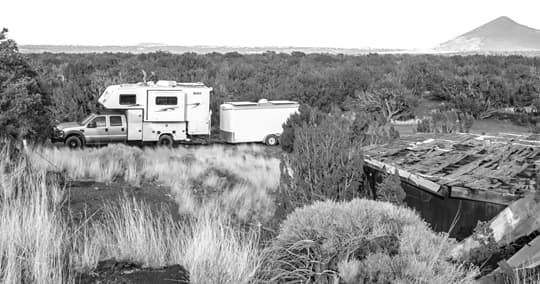
Above: A remote camp in the Coconino National Forest, Arizona
If you are like me, you look forward to traveling to a location to camp without a single man made object in sight; no phone poles, buildings, or fences within view. The only visible improvement might be the road you negotiated to arrive at your location.
At night there is not a single light to be seen, 360⁰ around you. Off on the distant nighttime horizon, you see a glow, defining the nearest town, forty miles away. The only pressure felt upon you is the weight of the nighttime sky and its carpet of stars as it defines the Milky Way.
This kind of off-the-grid solitude is accessible to everyone. Sometimes it takes considerable effort. Sometimes it’s just a matter of driving a few miles away from home. Either way, one needs to be comfortable with being in a remote location, far from the reaches of civilization.
As I sorely found out with my poor bride, you need to assess the remote camping comfort level of your fellow travelers. Talk with everyone with you, before you venture out.
Ask yourself and others in your party:
1. How do you feel about camping someplace where there are no campsites?
2. How do you feel about being in the camper, when it’s dark out, and there are no street lights in sight?
3. If there is an emergency, are you comfortable with the fact that you won’t be able to call for help with a cell phone? Even if you are able to, response will likely be more than an hour.
While you might crave the solitude and isolation, everyone may not feel as you do. Take small steps. Start out slow. Build the skills and comfort as the night and days pull in around you, creating that feeling, “I’m all alone!”.
I travel solo. What should I do to increase my own personal safety while traveling?
For individuals choosing to live part-time and even full-time on the road, there are many steps that can increase the level of personal safety while camping solo.
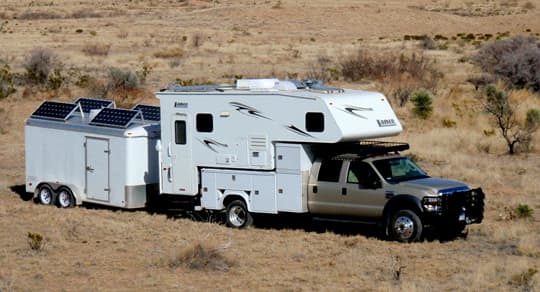
Above: Xtreme Boondocking, in the Chihuahuan Desert of southern New Mexico
Here’s are my eight personal safety tips for solo camping:
1. Stop broadcasting that you are single. When you greet people, speak in the fashion of, “we”.
2. Refrain from posting your locations via text and pictures on social media such as Facebook, Twitter, and Google+. If you do post information to social media, try posting when you are long gone from your present location.
3. If you use a program that tracks your progress and location, restrict access to this information to a trusted few.
4. Whenever possible, make it appear that you’re not alone. Leave extra glasses on the dash, and a pair of shoes of a different gender on the floorboard. Don’t set out one chair, but rather two or three.
5. If you have a friend that has a large dog, offer to buy him a new water dish. Then take the old beat up dish and set it up outside of your camper. A well placed sign of, “Beware of Dog,” is a nice touch too. If you are a dog person, consider bringing a dog.
6. When talking or visiting with people, be sure to keep a comfortable distance from the people around you. Be careful not to allow yourself to be boxed or trapped into a position that you are not able to walk away from.
7. Practice speaking and thinking in a confident fashion. Exhibit this confidence to others who you meet on the road.
8. Don’t be afraid to ask for local information on the places to avoid. Places to ask for this information include fire stations, police stations, and/or post offices. These locations often are easy to locate and full of great information, including where you might be able to camp for the night – boondocking style, of course!
Should I engage with the people I meet on the road?
Without a doubt, talk with people you meet on the road. One of the most satisfying and inspiring aspects of truck camping are the stories of the people I meet.
If you are not already, become a good listener. Develop this talent. Being a good listener will afford you the opportunity to learn more about the people around you.
By all means, if someone asks for details about yourself, share, but be willing to just share enough that they are not learning where you keep your spare cash and valuables. Be friendly, but avoid over-sharing.
If you have expensive hobbies, speak in generalities. For example, I rarely share the type of cameras I use or equipment I might have stored in my trailer. There are so many topics one can share without being specific about yourself.
Always maintain a safe distance, a personal safety bubble, between you and the people you meet. It is not always necessary to provide specific details of where you are camping or what town you are from. A general location and state of residence will suffice.
Once you have grown comfortable with the people you have met, share more. Trust your instincts.
What about the many dangerous animals I might encounter while boondocking in remote areas?
There are many animal, reptile and insect threats to you when camping in remote areas, some as small as bees, spiders, and mosquitos.
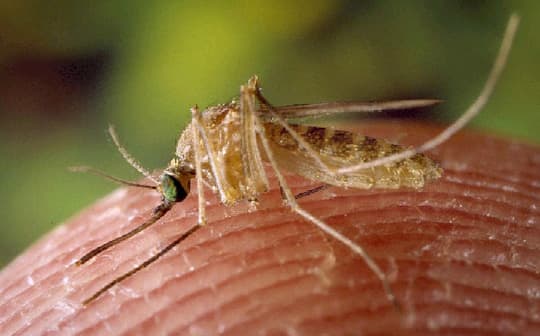
Above: Spraying the door frame and screens with insect DEET repellent will help keep mosquitoes away
1. Insects. You should know your susceptibility to insect bites and prepare accordingly. Spraying the door frame and screens with insect repellent will help in keeping many of these pests at bay. When outside, wear clothes that minimize exposed skin, and use insect repellent.
If you’re allergic to bee stings, have any necessary medication with you. Also check the ground around where you park to ensure you are not parking on top of a fire ant hill, as well as normal type ants.
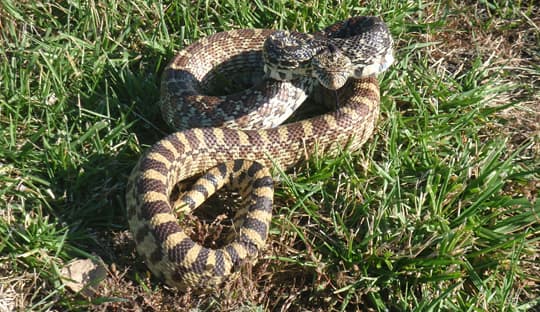
Above: A good snake, a non-poisonous Rat Snake, Saline County, Kansas
2. Reptiles. Reptiles, including poisonous snakes, can be prevalent in areas that truck campers travel through. The greatest dangers from poisonous snakes are to children and pets, which frequently explore new areas. When you’re in an area that could have poisonous snakes, keeping an eye on children and pets is critical.
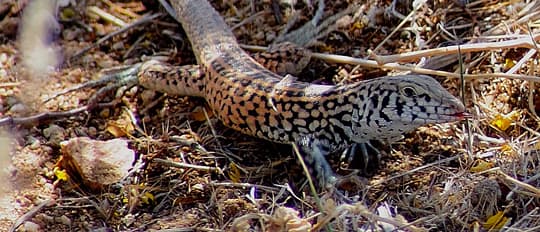
Above: Mojave Fringe Toed Lizard, Mojave Desert southwest California
Most reptiles are active in the warmer seasons, and move about in the Spring and Fall to and from their Winter nesting locations. If left unattended, always empty out shoes and containers before inserting hands and feet. Do not place hands onto or in locations that are not clearly visible.
Scorpions are also known to tuck themselves into places not visible. While the chance of encountering a dangerous snake or scorpion is low, caution is still needed.
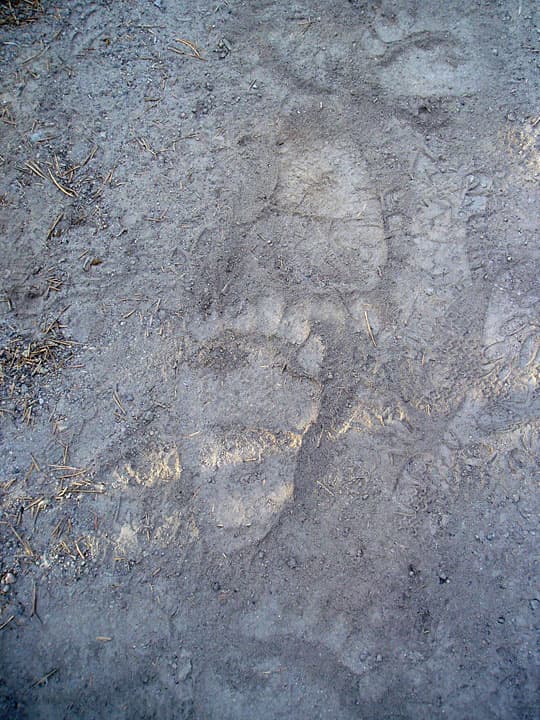
Above: Grizzly bear tracks, in Yellowstone National Park, Wyoming
3. Bears. There is a lot of readily available information about avoiding contact with bears. The basics include simply keeping your food secured in a fully-enclosed location and keeping a clean camp.
Your biggest potential bear problem will be the people around you as often they are not on the same level of bear safety. You are only as safe as the people around you. If one does see, or encounters a bear, remain calm. Refrain from eye contact, keep a safe distance; 100 yards or more. Walk/back away slowly to a safe distance. If a bear does charge, chances are it’s a bluff. Carrying bear spray has proven to be the most effective deterrent for up-close encounters.
Whenever you’re in bear country, avoid the areas where bears frequent and refrain from locations you are not able to see in 360⁰ around where you are. Also, know how to use the bear spray ahead of time, and carry the bear spray with you and not inside a pack.
Every year, the summer season begins for truck camping and so do the discussions pertaining to camping in and around bear country. For more than forty-five years, I have been hiking and backpacking in areas of the Rocky Mountains and the Northeast where bears live and prosper. During this time I have been lucky to have had the opportunity to witness bears in their own habitats and many encounters where I was within fifty yards of Grizzly and Black Bears in the backcountry. All of these encounters have been good ones, as well as for the majority of people.
What is important is to learn more about bears and what their habitats are. Then you will recognize when and where your chances of encountering bears will likely occur. With that knowledge, you are able to make a choice of whether or not you wish to camp in bear prone areas.
Black Bears can be encountered almost anywhere across the United States. Black Bears are not always black, as they are found to be even brown. Their size helps distinguish them from other bears in that they are typically under seven feet in length and under four hundred pounds.
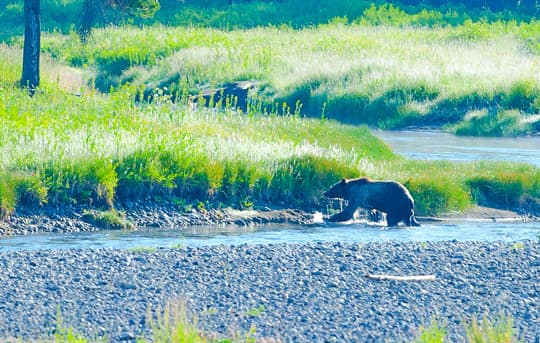
Above: Radio Collared Grizzly at Snake River Camp that just strolled by Bryan’s truck camper, one morning
Grizzly Bears can be found within the Northern Rockies and Pacific Northwest. A Grizzly will be up to ten feet in length, with a noticeable hump on its front shoulder. Grizzly Bears have a pan-shaped face and weigh up to eight-hundred pounds. Grizzlies are often found in meadows and lower valleys, where Black Bears can be encountered in heavy forests and mountainous terrains.
There are many sites that detail steps to take while traveling or camping in areas frequented by bears. Here is one example: http://www.yellowstone-bearman.com/b_spray.html
The most important point is to remain aware. Identify likely bear habitat and keep a clean camp, even when you are outside. Keep food secured at all times, not just when you are retired for the night. Keep surfaces clean of food debris, including the doors and handles that your food covered hands have come in contact with. Damage to campers can be devastating when bears are just cleaning off what you left on the side of your camper, after a night of grilling steaks.
While many subscribe to the safety firearms allow for protection from bears and other wildlife, recent studies, from many respected sources, have found that Bear Spray is more than effective in reducing injuries and possible death when bears have been encountered. Many owners of firearms are unfamiliar with the use and accuracy in using them against a larger animal, where Bear Spray can be utilized with very little training.
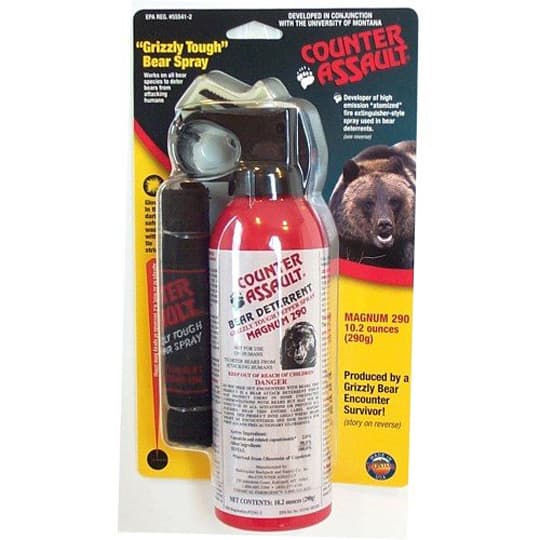
Bear Spray Link: http://www.amazon.com/10-2-Counter-Assault-Bear-Deterrent/dp/B005JPUY70/ref=pd_sim_sg_2?ie=UTF8&refRID=0KA5HT8W95E71W6PE083
The important factor is to have the Bear Spray close and not stored in a pack or compartment. Even while sitting out and enjoying a sunset, have your Bear Spray with you.
For years there have been discussions on whether pop-up truck campers are allowed in campgrounds in and around bear country. Unfortunately, there has been a lot of misinformation on this subject. Yes, they are allowed. There are exceptions, but often they are time related.
Often times law enforcement and other entities have to make spot decisions for a particular site. An authority does what’s called a; Compendium. For example, if there is a nuisance bear in a specific campground, the local authority may enact specific instructions for that area. When certain places have reoccurring bear problems, such as Yellowstone, Glacier or Smokey Mountains National Parks, checking their website or calling the information phone number will alert one of spot restrictions and/or closures.
Pop-up truck campers’ windows are very high off the ground. Opportunistic animals, like bears, will generally seek easier locations to enter and find food. Personally, I would be more concerned with intrusions from squirrels, raccoon, and porcupines.
While campground closures do occur, they are mostly due to an isolated situation due to a nuisance bear. Wholesale closure to pop-up truck campers is a myth. When staying in campgrounds in bear country, checking for spot closures is a good strategy. But having this as a reason for not considering a pop-up truck camper for a purchase, is unfounded.
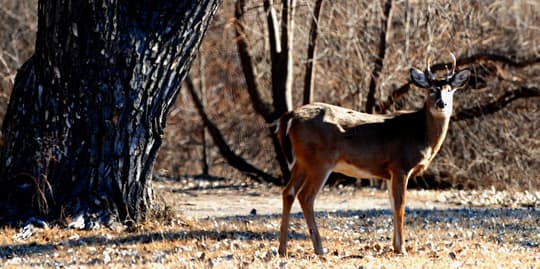
Above: White Tail Deer at Lake Kanopolis, Ellsworth County, Kansas
4. Elk. The animal I have had the most encounters with, meaning being charged and chased, are elk. It is so easy to allow yourself to come close to deer, elk, moose, bison and other animals we frequently have seen. Don’t. Leave a safe distance of 50 to 75 yards away from these animals. They can easily cover this distance between you and them, in the time it takes you to decide to take flight. If you do have one chase you, put a tree or other obstacle between you and the threat. Just keep in mind, elk have sharp hooves and a bison can weigh as much as a small car.
5. Rodents. Smaller animals can very easily damage or destroy important items in and around your truck and camper. I often keep rodent bait traps in the engine compartment of my truck. This is to keep mice and other rodents (including rabbits) from eating my wiring and insulation.
I often verify any fire causing nests are removed from my engine compartment, too. Just an overnight stop during the fall season can result in nesting. Be aware, and check.
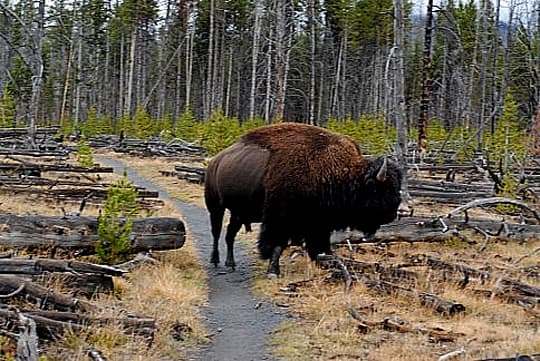
Above: A bison along the trail to Wolf Lake in Yellowstone National Park, Wyoming
One last animal tip; do not feed the wildlife, or leave food out for them, or for your own pets. You may not like who you invite to dinner.
When choosing a remote camping location, is there anything I should consider to increase my personal safety?
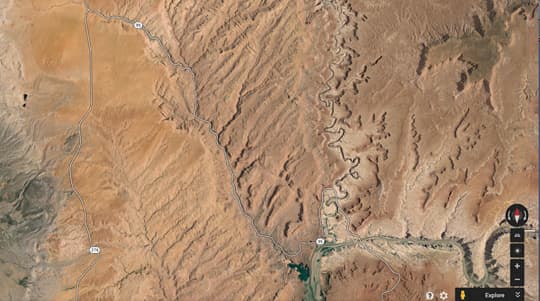
Above: Verify your location by reviewing satellite images of the area, Google Maps Satellite from Highway 95, Utah
Absolutely! Just like when I was a State Trooper, be aware of your surroundings. This is commonly called; situation awareness.
When possible, verify your location by reviewing satellite images of the area. To evaluate a potential remote camping location – and your situation awareness – ask yourself three simple questions:
1. Is there more than one route into and out of my potential camp?
2. Will I be able to see anyone coming toward my camp before they arrive?
3. Am I parked in a way I will be able to leave quickly if a threat materializes?
Is there anything I can do to safeguard my camper while I am away?
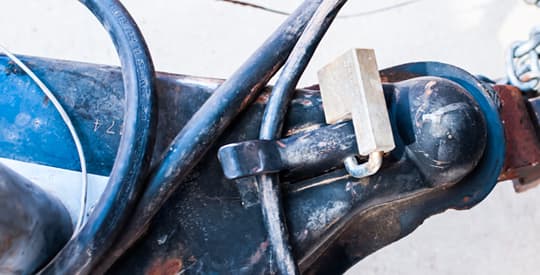
Above: Locking a tow trailer is a good way to safeguard your tow vehicle while you are away from it
I am off exploring for long periods of time and take steps to protect my property. The points I will share are some of the steps I take, or others take.
1. While you have determined your location is far away from other ways of entry, situate your vehicle in a fashion you can drive away immediately, without much hesitation. For example, when I was patrolling, I always watched and parked my patrol vehicle pointing out when checking campers or remote homesteads.
2. Don’t make a spectacle of your camper or truck. Refrain from drawing attention to yourself by using and displaying outside lighting. Don’t put reflector tape or decals on your vehicles to announce your locations to vehicle’s headlights passing through. Don’t fly flags, awnings, campfires, and smoke, to announce your location to others.
3. Don’t spread your contents out onto the ground like bicycles, motorcycles, carpets, whirly gigs, grills, and other paraphernalia. This could indicate to others whether you are home, or not.
4. Mark the road into your camp by dragging a stick across the road to leave a mark in the dirt and gravel. This will allow you to know whether someone has come into your camp while you are absent. I typically hike down the road/trail, mark half the road, and then do it again in a couple of other spots. Then, when I return, I just look for tread marks over these drag marks. Driving down the road, it is fairly difficult to see (thus avoid) these marks.
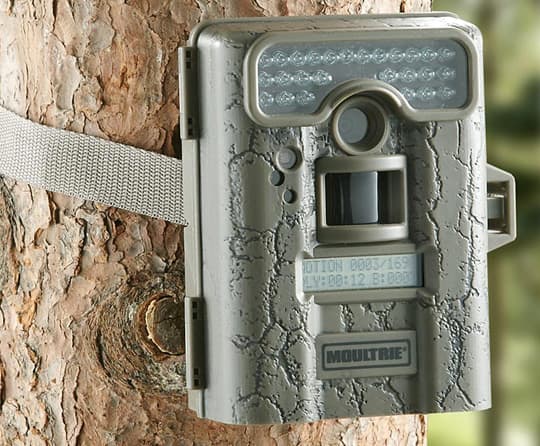
Above: Moultrie M-880 Mini Game Camera mounted on a nearby tree to keep an eye on an Xtreme Boondocking location
5. Use game cameras to record whom might be entering your camp by setting the cameras in strategic locations. At the minimum, you will have something recorded if you ever need it. Or, if you are lucky, a surprise of some interesting wildlife images.
6. A drive way alarm is a popular device used by rural residents. Many of these devices are now wireless and can be used when setting up a remote campsite.

Above: Security bolts on a solar panel can be used as a theft deterrent
7. Use locks, cables and security bolts on items such as solar panels, generators, roof ladders and anything that might be attached or on the outside of your truck and or camper.
8. Like you would at home, leave a radio on and (if it’s night time) an LED light on in the camper when you are away so as to affect a semblance of occupancy.
9. Vary your time at the camper by leaving and returning at different times. Don’t be in the habit of leaving early and returning late if you are staying multiple nights in a camp.
10. Don’t leave expensive items in view, by leaving your trailer doors and ramps open. I store my motorcycles in my trailer when I am back so as not to give information that I am there, or not.
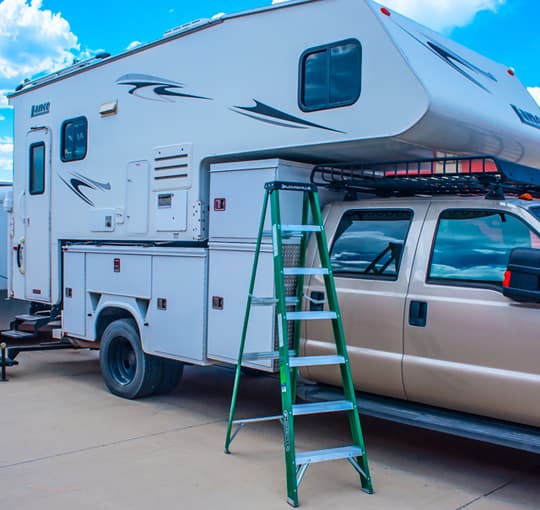
Above: Truck campers are much higher off the ground giving you an advantage over a travel trailer or pop-up camper
11. As a truck camper, you already have a vehicle much higher off the ground than a travel trailer or pop-up camper. High access to windows is a plus, for this reason. The windows on my truck camper are more than 8 feet off the ground.
12. Security cameras installed on and around your camper are recommended. While they might not stop an intruder, they are able to provide important investigation information.
13. Motion detector devices as well as lighting can do remarkable assistance to encourage man or animal to find another victim. Please use these devices with discretion as they can alert others of your location and provide irritation to those that seek total darkness (as I do).
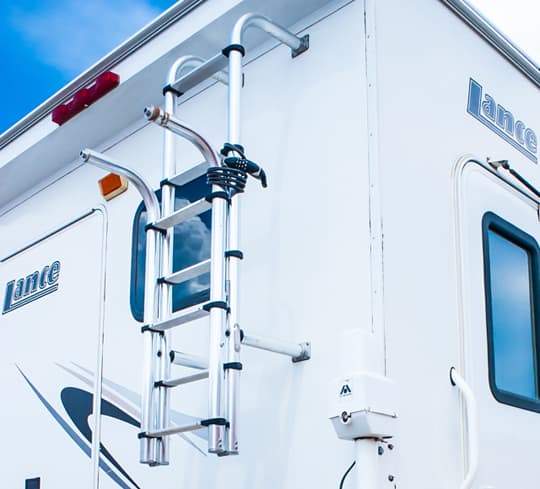
Above: Putting a bicycle cable lock can secure your folded up ladder to inhibit others from easy access to it
14. An often overlooked item on RVs is the ladder. Camper owners either attach an outside step ladder to their camper, or fails to secure the OEM ladder from unauthorized use. Fold up your ladder and use a bicycle cable lock to secure it folded. An easy point of interior access are the larger Heki skylights and vents. For this reason, ladder access to the roof needs to be secured.
15. Don’t talk about or post pictures of your camper and trailer contents on social media or announce your destination or dates of being there.
16. Don’t announce on your camper your status or what you carry inside through decals and or signs in your windows. The two worst violation of this suggestion; “Full-timing since 2009!”, “Canon Cameras”, or “Protected by Smith & Wesson”. I ask you, if you were only to break into one RV at a trail head, which one would you break into? The one with nothing on the outside, or the one that announces that they full-time or love Canon cameras?
17. Finally, remember to lock the lock on your camper door.
Click here for Personal Safety for Truck Campers – Part 2 where Bryan addresses the topic of carrying self-defense weapons and firearms while truck camping.
